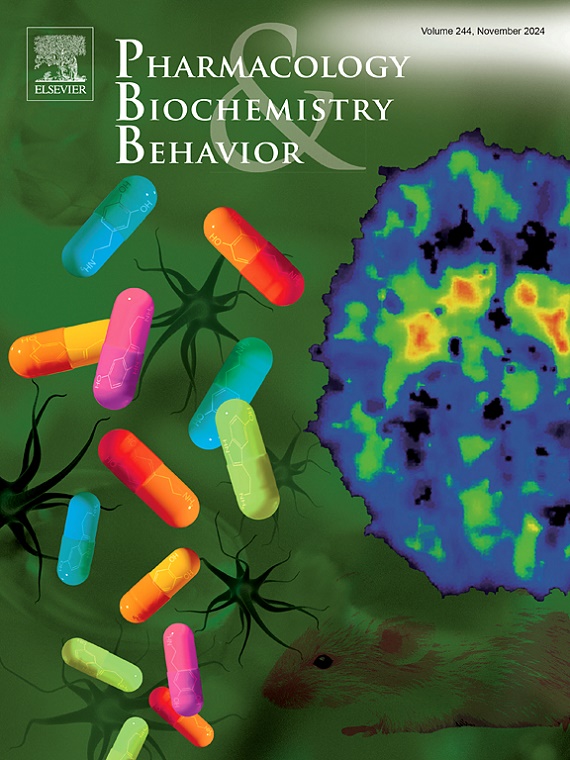雄性田鼠杏仁核中的多巴胺II型受体和下丘脑中的催产素共同调节着雄性田鼠的社会行为
IF 3.3
3区 心理学
Q1 BEHAVIORAL SCIENCES
引用次数: 0
摘要
杏仁核多巴胺(DA)系统和下丘脑催产素(OT)在情绪调节中起重要作用,情绪在调节社会行为中起重要作用。然而,杏仁核中的DA是否参与社会行为的调节,以及下丘脑中的OT是否也参与这一过程,目前尚不清楚。在这项研究中,我们检测了不同社会交往时多巴胺在内侧杏仁核(MeA)的释放,以及在内侧杏仁核注射多巴胺II受体(D2R)激动剂quinpirole和D2R拮抗剂raclopride对雄性田鼠(Microtus mandarinus)室旁核(PVN)和视上核(SON)以及血液中社交行为和OT的影响。结果表明,MeA中的DA在社交行为过程中有所增加,面对陌生人时的DA高于面对熟悉者时的DA。此外,在MeA中注射D2R拮抗剂减少了攻击和逃避行为,但增加了身体接触和调查行为,增加了PVN和SON中OT- ir神经元的数量,并增加了血液中的OT水平。虽然在MeA中注射D2R激动剂增加了攻击和逃避行为,但减少了身体接触和调查行为,但它也减少了SON中的OT-IR神经元。综上所述,内侧杏仁核的D2R和下丘脑的催产素调节着社会行为。本文章由计算机程序翻译,如有差异,请以英文原文为准。
Dopamine type II receptors in amygdala along with oxytocin in hypothalamus regulate social behavior in male mandarin voles
The amygdala dopamine (DA) system and hypothalamic oxytocin (OT) play important roles in emotion regulation, and emotions are important in regulating social behavior. However, it is unclear whether DA in the amygdala is involved in the regulation of social behavior, and whether OT in the hypothalamus is also involved in this process. In this study, we examined the release of DA in the medial amygdala (MeA) during different social interactions and the effect of injecting the dopamine II receptor (D2R) agonist quinpirole and the D2R antagonist raclopride into the MeA on social behavior and OT in the paraventricular nucleus (PVN) and supraoptic nucleus (SON), as well as in the blood of male mandarin voles (Microtus mandarinus). The results showed that the DA in the MeA increased in the process of social behavior, and the DA in the face of strangers was higher than that in the face of familiars. In addition, the injection of D2R antagonists in the MeA reduced attacking and escaping behaviors but increased physical contact and investigating behaviors, increased the number of OT-IR neurons in the PVN and SON, and increased OT levels in the blood. While injection of D2R agonists in the MeA increased attacking and escaping behaviors but reduced physical contact and investigating behaviors, it also reduced OT-IR neurons in the SON. In conclusion, D2R in the medial amygdala and oxytocin in the hypothalamus regulate social behavior.
求助全文
通过发布文献求助,成功后即可免费获取论文全文。
去求助
来源期刊
CiteScore
6.40
自引率
2.80%
发文量
122
审稿时长
38 days
期刊介绍:
Pharmacology Biochemistry & Behavior publishes original reports in the areas of pharmacology and biochemistry in which the primary emphasis and theoretical context are behavioral. Contributions may involve clinical, preclinical, or basic research. Purely biochemical or toxicology studies will not be published. Papers describing the behavioral effects of novel drugs in models of psychiatric, neurological and cognitive disorders, and central pain must include a positive control unless the paper is on a disease where such a drug is not available yet. Papers focusing on physiological processes (e.g., peripheral pain mechanisms, body temperature regulation, seizure activity) are not accepted as we would like to retain the focus of Pharmacology Biochemistry & Behavior on behavior and its interaction with the biochemistry and neurochemistry of the central nervous system. Papers describing the effects of plant materials are generally not considered, unless the active ingredients are studied, the extraction method is well described, the doses tested are known, and clear and definite experimental evidence on the mechanism of action of the active ingredients is provided.

 求助内容:
求助内容: 应助结果提醒方式:
应助结果提醒方式:


